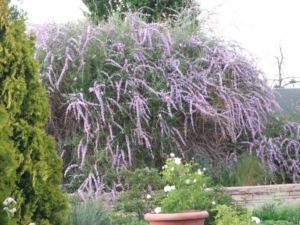Gardening as a Spiritual Path
Gardening is the New Meditation
by Sandy Swegel
Over the last few months, I’ve recommitted myself to a meditation practice. It’s a simple practice of Centering Prayer, sitting 20 minutes twice a day, although most days I’m lucky to manage one session. The fruits of a meditation practice (like those of a garden) come over time. With regular practice, one slowly notices one is more calm, more able to handle the daily turmoils of living, more able to see things from a larger perspective. With persistence and time, the meditator has a chance to become a more loving, compassionate and happier person.
In many ways, I live a split life. I have a group of friends who meditate and focus on spirituality, and I have a different group of friends who focus on gardening. It is one of my pet theories that Gardening is the New Church. Many people come together in community to garden, especially to grow food. Gardeners meet regularly to support one other, they teach their children in the church of nature, they help the poor by giving away extra produce to food banks, and they join together to do gardening service projects in their community or to help older people who can’t garden alone anymore. It’s a pretty amazing phenomenon.
I invite you to become more aware of gardening as a spiritual path for you. Our BBB Seed Facebook page statistics give us lots of clues to how important gardening and nature is to you. The pictures and blog posts you “like” the most are the ones that are the most spiritual or transcendent. You “like” pictures of dramatic landscapes and pictures of the simple beauty of a single flower or a whimsical thought. You “share” articles about esoteric topics like Forest Bathing.
When I blog I like to give lots of practical advice about how to grow things because I want you to be successful at gardening. So many people try to garden and give up because they fail in some way…usually because of not knowing what a plant needs. I’ll keep teaching those things, but this year I want to write more about the spiritual practices of gardening. I hope this will be a conversation too about how gardening and nature uplift your spirit.
It’s almost sunrise when I’m writing right now, and I’m off to complete one of my favorite simple spiritual practices. I walk outside to greet the sunrise. I observe the reds and pinks and golds of the morning sky. I breathe in the fresh cold morning air and breathe out any negativity. I think about three things I’m grateful for. I compliment the sun on how beautiful he is this morning. And I send out a blessing over the earth with each day’s new sun. Amen.



 Edition: (and Fruits, Nuts, Berries, Grains, and Other Crops) continues to be the best way to design your vegetable garden and decide what and how much to plant to become self-sufficient.
Edition: (and Fruits, Nuts, Berries, Grains, and Other Crops) continues to be the best way to design your vegetable garden and decide what and how much to plant to become self-sufficient. niently online.
niently online.



 et browsing.
et browsing.

 er and many plants are tiny, but the lovely routine of the season has started.
er and many plants are tiny, but the lovely routine of the season has started. get smarter –in gardening, in life, in work, and in love—but some of us are slow or stubborn learners and by the time we finally “get” something and understand with clarity, we’re already getting a bit crickety and reaching a “mature” age. But it doesn’t have to be this way with gardening. Gardeners are natural teachers and mentors and are generous to share the wisdom of their hard-learned lessons.
get smarter –in gardening, in life, in work, and in love—but some of us are slow or stubborn learners and by the time we finally “get” something and understand with clarity, we’re already getting a bit crickety and reaching a “mature” age. But it doesn’t have to be this way with gardening. Gardeners are natural teachers and mentors and are generous to share the wisdom of their hard-learned lessons. on: Growing Vegetables in the West. I’ve spent the last week with this book and I’m surprised how many new things I’ve learned….and I’m a gardening research junkie who scours the internet and grills friends and strangers about gardening practices. Jane has gathered the gardening wisdom of her lifetime and the life-long wisdom of stellar home and professional gardeners, scientists and entrepreneurs, and written a book that will teach you advanced gardening techniques but is still beautiful to read and easy to understand. Sort of Acres Magazine meets Martha Stewart Gardening.
on: Growing Vegetables in the West. I’ve spent the last week with this book and I’m surprised how many new things I’ve learned….and I’m a gardening research junkie who scours the internet and grills friends and strangers about gardening practices. Jane has gathered the gardening wisdom of her lifetime and the life-long wisdom of stellar home and professional gardeners, scientists and entrepreneurs, and written a book that will teach you advanced gardening techniques but is still beautiful to read and easy to understand. Sort of Acres Magazine meets Martha Stewart Gardening.